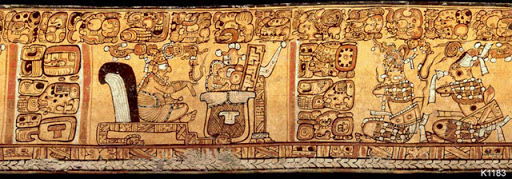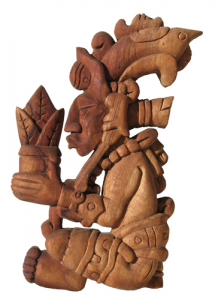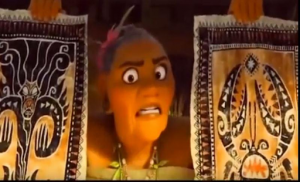The Maya Genesis Story, also known as the Maya Creation Story, can be found in the Maya book called, “Popol Vuh,” or “The Book of the People.” Luckily, this book was not destroyed when the Spanish invaded in the 18th Century, making the “Popol Vuh” a valuable historical text and a great way for us to learn about the Maya people and their beliefs.

 The Maya Creation Story begins with the Maize God known as “Hun Hunahpu.” He was tricked into going down to the underworld where the Gods of the underworld decapitate him. The Maize God’s sons the Hero Twins hear what happened to their father and went to save him, but the only way for them to get to the underworld is to be burned alive, and have their ashes thrown into the water. Once the Hero Twins are poured in the water, they regenerate to their human form and continue to travel to the underworld until they are stopped by the Gods of the underworld. The Hero Twins challenge the Gods of the underworld to play their Mayan Ball Game, with the stakes that if they win, they get the head of their father back and if they lose, they will remain in the underworld for eternity. The Hero Twins were victorious and received the Maize God’s head. They returned to earth and planted the Maize God’s head in the ground. From the buried head, a stock of maize (corn) grew. This crop became the food source that created and sustained the Maya Civilization.
The Maya Creation Story begins with the Maize God known as “Hun Hunahpu.” He was tricked into going down to the underworld where the Gods of the underworld decapitate him. The Maize God’s sons the Hero Twins hear what happened to their father and went to save him, but the only way for them to get to the underworld is to be burned alive, and have their ashes thrown into the water. Once the Hero Twins are poured in the water, they regenerate to their human form and continue to travel to the underworld until they are stopped by the Gods of the underworld. The Hero Twins challenge the Gods of the underworld to play their Mayan Ball Game, with the stakes that if they win, they get the head of their father back and if they lose, they will remain in the underworld for eternity. The Hero Twins were victorious and received the Maize God’s head. They returned to earth and planted the Maize God’s head in the ground. From the buried head, a stock of maize (corn) grew. This crop became the food source that created and sustained the Maya Civilization.
 The Maya highly value the creation story of the Maize God and the Hero Twins because maize is the staple crop of the Maya civilization. Every harvest season they hold rituals to honor the Maize God and the Hero Twins for the continued abundance of the corn they harvest every year. Rituals to celebrate the story of the Maize God and the Hero Twins are still practiced by the modern Maya people. These rituals provide an opportunity to share the creation story with the younger generation, to help them learn about their ancestry. You can watch the ritual being performed and discussed by Morgan Freeman in the National Geographic Series, “The Story of God.”
The Maya highly value the creation story of the Maize God and the Hero Twins because maize is the staple crop of the Maya civilization. Every harvest season they hold rituals to honor the Maize God and the Hero Twins for the continued abundance of the corn they harvest every year. Rituals to celebrate the story of the Maize God and the Hero Twins are still practiced by the modern Maya people. These rituals provide an opportunity to share the creation story with the younger generation, to help them learn about their ancestry. You can watch the ritual being performed and discussed by Morgan Freeman in the National Geographic Series, “The Story of God.”
The ritual looks very simple but holds significant meaning to the Maya Civilization. The ritual space is set up with three stones in the center of the circle where participants gather around and listen to the shaman’s retelling of the Maya Creation Story. The three stones symbolize the past, present, and the future of the Maya Civilization. As the shaman narrates the story, she gathers water in a jug and pours ashes into the water to symbolize the Hero Twins being burned and regenerating so they can travel to rescue the Maize God. As the ritual and story progress, the shaman adds corn kernels in the water jug. This part of the ritual is a symbol of how the Hero Twins win the Maya Ball Game and return to plant the Maize God’s head in the ground, thus creating maize and the Maya Civilization. As the shaman wraps up the retelling, she passes around a cup with the contents of the ritual water to the participants. Each person takes a sip of the concoction as a symbol of gratitude for the Maize God and Hero Twins for providing the crop that has kept their civilization growing from the past to the present day and into the future.
Along with the rituals, the Maya Creation story is woven into the fabric of their daily lives and appears in their décor, architecture, and paintings.Having this imagery around throughout their lives is another way for their creation story to be past along throughout generations. At the site of an ancient city, Tikal, archaeologists found a stairway made of stucco. The ornately carved steps depicted the Maya Creation Story, the Maize God, and the Hero Twins. This is a particularly interesting discovery for archaeologists and us because it reminds us of similar artistic creations that hang in museums around the world depicting the Christian creation story, such as the painting, “The Creation of Adam.” It is important to know that every culture and many religions have their own creation stories that are shared with new generations.
 Even Disney films such as Moana are helping to show other culture’s myths and creation stories. Often these different cultures, such as those in the Polynesian Island of Samoa, have a ritual of retelling their own version of the creation story to pass on through generations. Different cultures like the Egyptians and Greeks have their creation stories written on clay or stone tablets as well as have carvings of the imagery around their villages. You can also discover the Maya Creation Story depicted on a vase in The Maya Hidden Worlds: Revealed exhibit at the Connecticut Science Center.
Even Disney films such as Moana are helping to show other culture’s myths and creation stories. Often these different cultures, such as those in the Polynesian Island of Samoa, have a ritual of retelling their own version of the creation story to pass on through generations. Different cultures like the Egyptians and Greeks have their creation stories written on clay or stone tablets as well as have carvings of the imagery around their villages. You can also discover the Maya Creation Story depicted on a vase in The Maya Hidden Worlds: Revealed exhibit at the Connecticut Science Center.
Creation stories are a huge part of many cultures. They help to define the customs of that individual culture, which civilizations thrive on since the stories help shape how they live their lives, explain why they worship differently than other cultures around the world, and serve as a way to pass their cultures forward with new generations. By examining diverse creation stories we can explore why we have our own versions of how our civilization came into existence. You can also discover the Maya Creation Story depicted on the Buena Vista vase in The Maya: Hidden Worlds Revealed exhibit at the Connecticut Science Center.
Stay connected! Be sure to subscribe to Down to a Science— The Official Blog of the Connecticut Science Center and follow us on social media.

Sarena Salmeri is an intern for the Maya: Hidden Worlds Revealed exhibit. In her role she helps to educate visitors about various aspects of the Maya Culture, as well as research different Maya ways of life as they live today and have in the past. She is working towards her bachelor’s degree in Cultural Anthropology at Southern Connecticut State University, aspiring to work as an ethnographer and in museum curation. In her free time, she enjoys taking her dog for long walks across town, collecting artwork from the places she has traveled, and reading different ethnography books about a variety of cultures.



